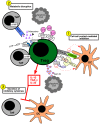Generation and function of induced regulatory T cells
- PMID: 23801990
- PMCID: PMC3685796
- DOI: 10.3389/fimmu.2013.00152
Generation and function of induced regulatory T cells
Abstract
CD4(+) CD25(+) Foxp3(+) regulatory T (Treg) cells are essential to the balance between pro- and anti-inflammatory responses. There are two major subsets of Treg cells, "natural" Treg (nTreg) cells that develop in the thymus, and "induced" Treg (iTreg) cells that arise in the periphery from CD4(+) Foxp3(-) conventional T cells and can be generated in vitro. Previous work has established that both subsets are required for immunological tolerance. Additionally, in vitro-derived iTreg cells can reestablish tolerance in situations where Treg cells are decreased or defective. This review will focus on iTreg cells, drawing comparisons to nTreg cells when possible. We discuss the molecular mechanisms of iTreg cell induction, both in vivo and in vitro, review the Foxp3-dependent and -independent transcriptional landscape of iTreg cells, and examine the proposed suppressive mechanisms utilized by each Treg cell subset. We also compare the T cell receptor repertoire of the Treg cell subsets, discuss inflammatory conditions where iTreg cells are generated or have been used for treatment, and address the issue of iTreg cell stability.
Keywords: TCR repertoire; Treg cells; Treg function; Treg stability; gene expression profiling; immunotherapy.
Figures

References
-
- Apostolou I., Sarukhan A., Klein L., von Boehmer H. (2002). Origin of regulatory T cells with known specificity for antigen. Nat. Immunol. 3, 756–763 - PubMed
Grants and funding
LinkOut - more resources
Full Text Sources
Other Literature Sources
Research Materials

